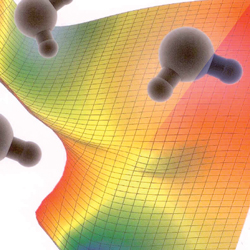Computational Spectroscopy
 Computational spectroscopies based on ab initio simulations play a pivotal role in interpreting experimental measurements by providing microscopic physical insights. These insights correlate spectral features to underlying structural, electronic, and magnetic properties of materials. With rapid advancements in theory and the growing integration of machine learning (ML), new opportunities are emerging to develop computational spectroscopy tools that combine physics-based modeling with ML to greatly enhance both fidelity and efficiency. This new paradigm paves the way for real-time spectral analysis in contexts such as autonomous experimentation and materials design. This special issue showcases state-of-the-art theoretical and ML approaches—particularly in Vibrational Spectroscopy, X-ray Spectroscopy, Nuclear Magnetic Resonance (NMR), and UV/Visible Spectroscopy—and highlights their effectiveness in probing the structure and dynamics of complex systems. Target systems include both bulk phases and interfaces.
Computational spectroscopies based on ab initio simulations play a pivotal role in interpreting experimental measurements by providing microscopic physical insights. These insights correlate spectral features to underlying structural, electronic, and magnetic properties of materials. With rapid advancements in theory and the growing integration of machine learning (ML), new opportunities are emerging to develop computational spectroscopy tools that combine physics-based modeling with ML to greatly enhance both fidelity and efficiency. This new paradigm paves the way for real-time spectral analysis in contexts such as autonomous experimentation and materials design. This special issue showcases state-of-the-art theoretical and ML approaches—particularly in Vibrational Spectroscopy, X-ray Spectroscopy, Nuclear Magnetic Resonance (NMR), and UV/Visible Spectroscopy—and highlights their effectiveness in probing the structure and dynamics of complex systems. Target systems include both bulk phases and interfaces.
Topics covered include, but are not limited to:
- Vibrational spectroscopy
- X-ray spectroscopy
- nuclear magnetic resonance (NMR)
- UV/Visible spectroscopy
- theoretical methods for probing bulk phases (e.g., electrolytes, solutions)
- theoretical approaches for studying interfaces (e.g., solid/liquid, liquid/liquid, liquid/air interfaces)
- computational investigation of biomolecular structures
- spectroscopic analysis of chiral molecules
Guest Editors
Fujie Tang, Xiamen University
Shaul Mukamel, University of California Irvine
Deyu Lu, Brookhaven National Laboratory
Yuki Nagata, Max Planck Institute for Polymer Research
David Wilkins, Queen’s University Belfast
